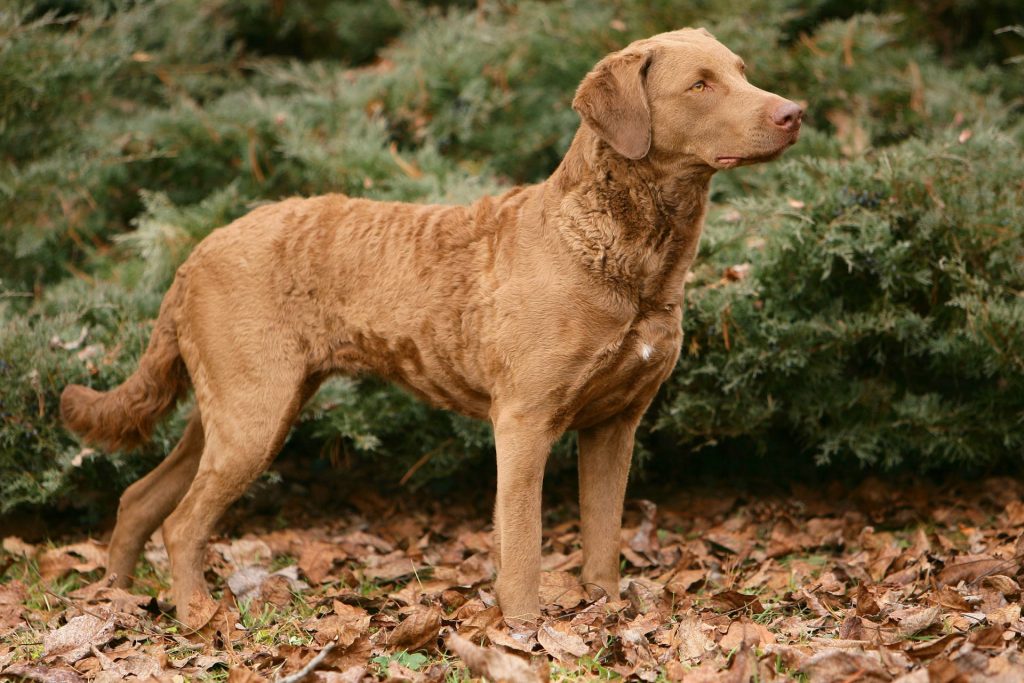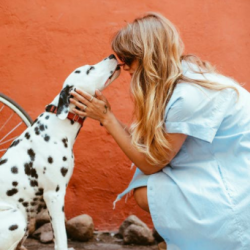
The Chesapeake Bay Retriever is an excellent gun dog that likes to swim and can work well in cold weather. This is a large dog that has a distinctive oily and watery smell. The dogs are protective, loyal and affectionate and make good family pets.
The AppearanceHeight: 20-27 inchesWeight: 45-80 poundsLifespan: 10-12 years, average
The Chesapeake Bay Retriever is a robust dog with a sturdy body and webby legs. The head is broad in the skull with a distinctive oily and watery nose and the muzzle is broad with a broad stop. The eyes are dark and large whichrimmon the head. The chest is wide and deep, the body heavy and sturdily built.
The Chesapeake Bay Retriever has a dense wavy, medium length, short-haired coat that is relatively easy to groom. This breed has a mild mannered demeanour.
Use in the Field
The Chesapeake Bay Retriever is a good gundog used both in small packs and alone for retrieving fowl. They can take on almost any waterfowl, and will even go after any non-reptile wildlife. It is best to hunt with a partner, as they tend to do best when they are with another dog.
The dog is famous as a partner for any kind of water activity. They are popular for their high tolerance to pain and fatigue in the water. They are not so ideally suited to waterfowl retrievals, but their retrieving instincts make them good for smaller game, such as fur-hunting.
At home, the Chesapeake Bay Retriever is fine with the family and great with children. They do tend to show strong territorial instincts, and will guard the yard from strange dogs. Other pets in the house are generally do well, except for the tailchow.
This is a docile dog and will get along well with strange pets.
The Basics for Your Chesapeake Bay Retriever
The basic requirements for your Chesapeake Bay Retriever include:
· A Front DeW progression ( fuller worm)· High quality pet food· Frequent health checks and vaccinations.· A history of worm infestations.· A stainless steel food and water bowl.· A comfortable bed.· A valued reputable lifetime hunting dog or pet.
The Chesapeake Bay Retriever is also known to be picky eaters. Sometimes if you put the puppy food into a larger bowl they will not eat it. They have a tendency to eat when they’re bored or overexcited. This is a common problem. There is a product called CHELY Options that puts a bitter solution on dry food to discourage Leaving it in the bowl. Remember, this may not work for all puppies. This product is available athttp://www.chacy options.com.
Health
The Chesapeake Bay Retriever is a generally healthy dog, with a life span of 12 to 14 years. They are a medium sized dog standing about 5 to 10 inches tall and weighing about 14 to 18 pounds.
Because of their short muzzle, the Chesapeake Bay Retriever is prone to breathing problems, such as snoring and wheezing. Excessive panting and other derogatory noises such as hiss can also be associated with this breed. They are also predisposed to obesity. Vets who have payroll as a service recommend you do about 5 repeats at about 20 minutes each to correct this habit.
Like many other dogs, there are a few other health conditions that affect the Chesapeake Bay Retriever. They include:
· Canine Hip Dysplasia is a skeletal disease. The hip’s not perfectly formed resulting is a severe joint reaction that can cause lameness. The symptoms are limping or using a short leg; when standing, the dog has a hard time walking right, and has a tendency to hold its breath.· Treopia is a condition where the retina develop out of place. The resulting eye diseases are commonly called cataracts, in which the dog has a tendency to see erratically.· employment-related hip dysplasia is a condition in which the thigh bone does not fit into the socket. The Nature of this disease is that it leads to stress on the hips; this is treated surgically. There are exercises you can do to help your dog exercise more, and avoid this joint problem.· Osteochondrosis is a condition in which the cartilage of the shoulders, hips, and elbows actually deteriorates. This disorder shows up by limping, and when exercised regularly the intense pain is reduced. This can be treated with anti-inflammatory drugs and reduce the pain.· Degenerative myelopathy, a disease of the nerves, is a disease of the nerves, and can be seen.

